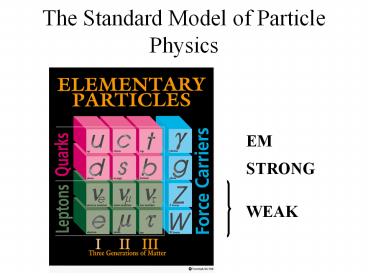The Standard Model of Particle Physics PowerPoint PPT Presentation
1 / 22
Title: The Standard Model of Particle Physics
1
The Standard Model of Particle Physics
EM
STRONG
WEAK
2
Interactions and Decays
- Forces are responsible for
- Interactions
- Decays
- Decays are really a type ofinteraction though
3
What do I mean by an Interaction?
1 2 ? 3 4
4
What do I mean by a Decay ?
1 ? 3 4
1
5
Conservation Laws
Conservation Laws, or alternately, conserved
quantities, allow you to place constraints on
what types of interactions and decays can or
cannot occur.
6
Conserved Quantities
Consider the process where two particles A and B
collide, and produceparticles C and D
A B ? C D
By conserved, we simply mean that the value on
the left hand sidemust equal the value on the
right hand side.
- Some of the most important examples are
- Total energy is ALWAYS conserved energy
cannot be created nor destroyed, only
transformed - Total momentum is ALWAYS conserved
- Total charge is ALWAYS conserved - cannot
simply create net charge
7
Energy Conservation (I)
A B ? C D
If you knew any 3 of the energies, you could
compute the fourth! ? So, in such a reaction,
you only need to measure 3 particles, andenergy
conservation allows you to compute the fourth!
8
Energy Conservation (II)
A B ? C D
9
Energy Conservation (III)
A ? B D
If particle A has non-zero mass (mA gt 0), then
mB lt mA
mD lt mA
This must be true, otherwise energy would not be
conserved !
This canthappen ifMBgtMA, orMDgtMA
10
Energy Conservation (IV)
So, energy conservation helps in 2 ways
1. It allows you to predict the energy of
particles which you do not, or cannot
measure.2. It may tell you that a process
cannot occur, since energy conservation cannot
be violated!
11
Momentum Conservation (I)
- Momentum conservation is used just as frequently
as energy conservation - The classic scenario is the case of neutron
decay
p
n
mP
me
e
neutron at rest decays to a proton electron
12
Momentum Conservation (II)
neutron at rest appears todecay to a proton
electron
p
n
mP
me
e
Total Momentum Before Decay Total Momentum
after Decay
P(neutron) P(proton) P(electron)
0 P(proton) P(electron)
We dont know what the value is, but we know it
is NOT zero. In other words the proton and
electrons momentum cannot cancel, because they
are in the same direction!
13
Momentum Conservation (III)
neutron at rest appears todecay to a proton
electron
p
n
mP
me
e
Since both the electron and proton are both
moving off to theright, their total momentum
cannot be zero.
? In other words, this reaction cannot occur,
since itwould violate momentum conservation.
14
Charge Conservation (I)
Again, lets consider the process
A B ? C D
- Charge conservation implies that
Charge of particle A Charge of particle B
Charge of particle C Charge of particle D
So, if you know the charge of any 3 of the
particles, you canimmediately say what the
charge of the 4th MUST BE!
15
Charge Conservation (II)
A B ? C D
16
Other conserved quantities
Baryon Number Conservation When we collide
particles together, we find that the number
ofbaryons is conserved.
A B ? C D
- For each baryon, we simply assign B 1
(protons, neutrons,for example) - For each anti-baryon ,we assign B -1
(antiprotons, antineutrons,for example) - Compute the total baryon number on each side and
they must be equal!
17
Baryon Number Conservation (I)
A B ? C D
18
Lepton Number Conservation (I)
Electron, Muon and Tau Lepton Number
We find that Le , Lm and Lt are each conserved
quantities
19
Lepton Number Conservation (II)
Lets look at how this works
p ? m nm
?
Lm
0
-1
1
m ? e g
20
Lepton Number Conservation (III)
More examples
g ? e e-
?
Le
0
-1
1
p ? m ne
21
There is no such thing asMeson Number
CONSERVATION
22
Summary of Conservation Laws
- Conservation of Total Energy
- Conservation of Total Momentum
- Conservation of Baryon Number
- Conservation of Lepton Number
- These conservation laws always apply
- There are other conservation laws, but they only
apply to certain forces. I will expound upon
this later

